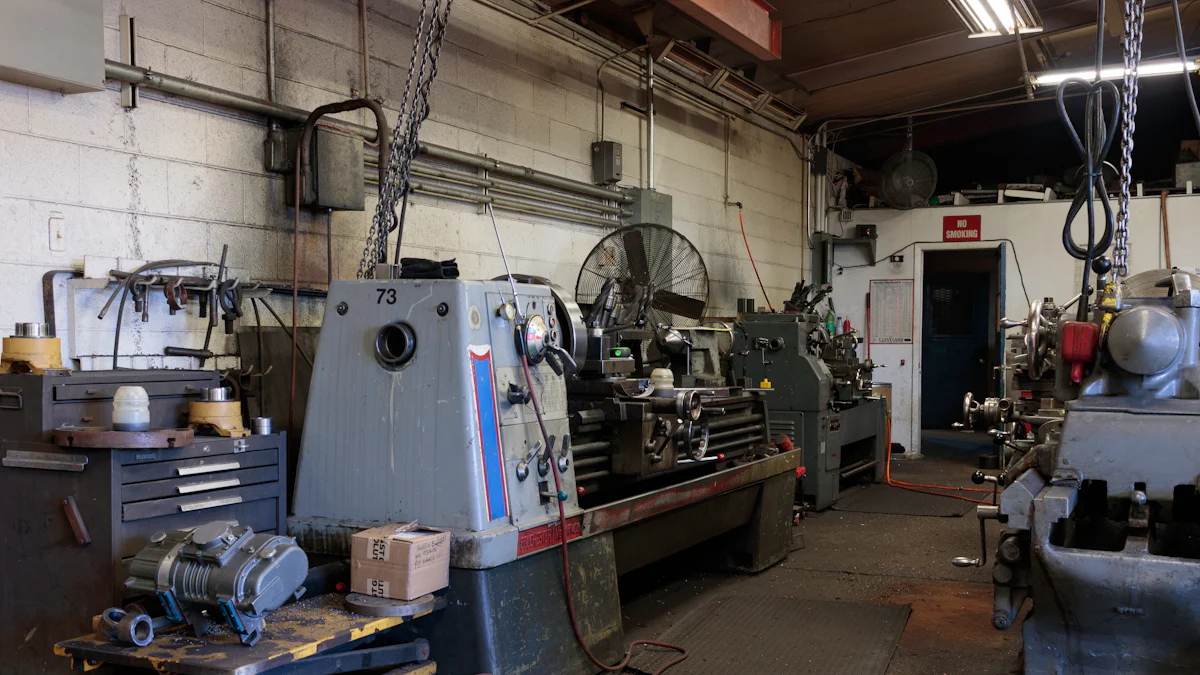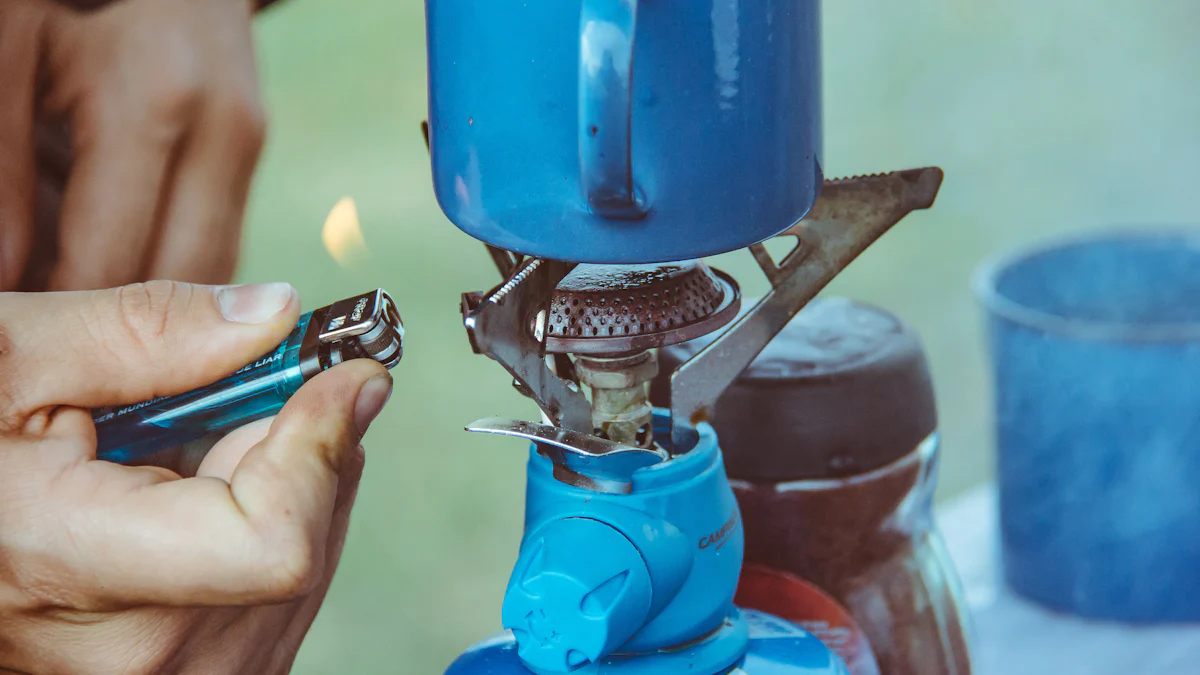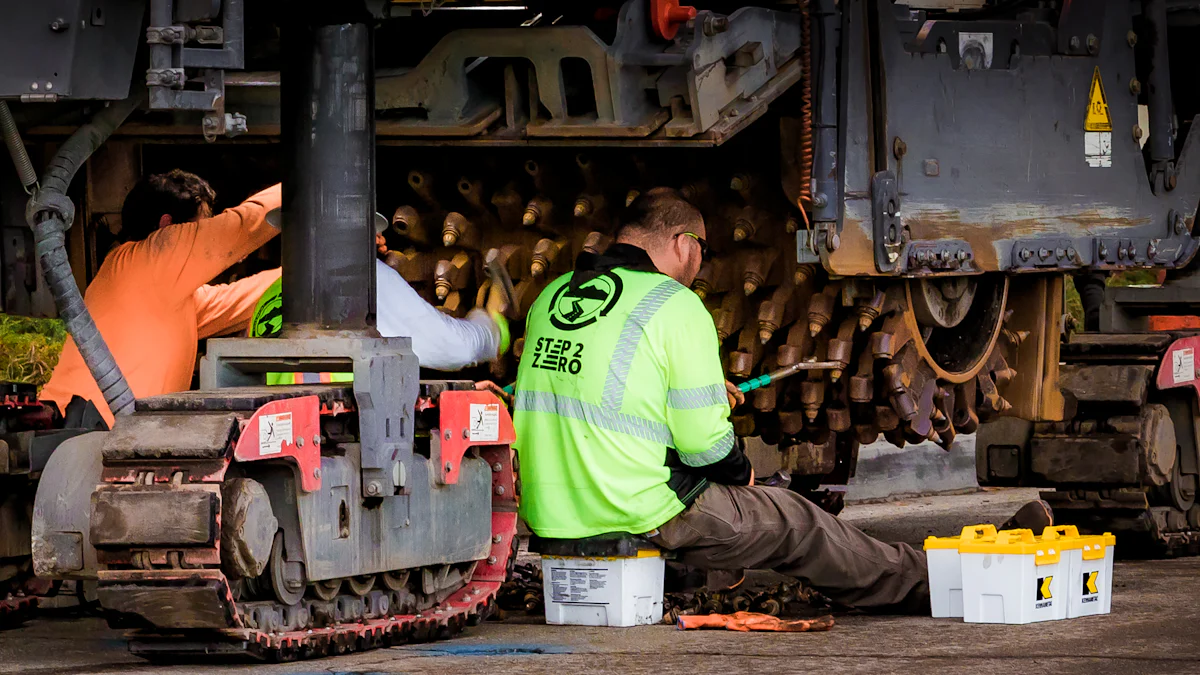
Maintaining your lighter making machine is essential for safety and efficiency. Regular care ensures the machine operates smoothly and lasts longer. Neglecting maintenance can lead to costly repairs or even dangerous malfunctions. For example, a poorly maintained Gas Filling Machine may cause leaks, posing safety risks. Proper upkeep prevents these issues and boosts performance.
Key Takeaways
- Check the machine often to find problems early. Make a list to check all important parts every time.
- Clean the machine by getting rid of dust and dirt. Clean it every week to keep it working well.
- Use the right oils made for the machine parts. This stops damage and helps it run smoothly.
Regular Inspections for Lighter Making Machines
Regular inspections play a vital role in keeping your lighter making machine in top condition. By identifying potential problems early, you can avoid costly repairs and ensure smooth operation.
Identifying Wear and Tear
Inspecting your machine for wear and tear helps you catch small issues before they become major problems. Look closely at components like belts, gears, and seals. Cracks, fraying, or unusual thinning often indicate wear. Pay attention to any unusual noises or vibrations during operation. These signs may point to parts that need replacement. Use a flashlight to check hard-to-see areas, ensuring no damage goes unnoticed. Regularly inspecting these elements keeps your machine running efficiently and reduces downtime.
Tip: Create a checklist for inspections. This ensures you don’t miss any critical parts during your routine checks.
Checking Alignment of Moving Parts
Misaligned moving parts can cause your lighter making machine to malfunction. Check the alignment of belts, pulleys, and other moving components. Misalignment often leads to uneven wear, reduced efficiency, or even machine failure. Use a straightedge or alignment tool to verify that parts are properly aligned. If you notice any deviation, adjust the components immediately. Proper alignment not only extends the life of your machine but also improves its overall performance.
Note: Always turn off the machine and disconnect it from power before inspecting or adjusting moving parts.
Cleaning the Lighter Making Machine

Removing Dust and Debris
Dust and debris can accumulate on your lighter making machine over time, affecting its performance. Regular cleaning prevents these particles from clogging critical components. Start by turning off the machine and disconnecting it from the power source. Use a soft brush or a dry cloth to wipe away visible dust from the surface. Pay close attention to areas around vents, gears, and other openings where debris tends to collect. For hard-to-reach spots, compressed air works well to dislodge particles without damaging the machine.
Avoid using water or liquid cleaners unless the manufacturer specifically recommends them. Moisture can corrode metal parts and lead to electrical issues. By keeping your machine free of dust and debris, you ensure smoother operation and reduce the risk of malfunctions.
Tip: Schedule a weekly cleaning routine to prevent excessive buildup and maintain optimal performance.
Using the Right Cleaning Tools
Using the correct tools makes cleaning your lighter making machine more effective and safer. Soft brushes, microfiber cloths, and compressed air are ideal for removing dirt without scratching or damaging surfaces. For stubborn grime, use a manufacturer-approved cleaning solution. Always check the user manual for specific recommendations to avoid voiding the warranty.
Avoid abrasive materials like steel wool or harsh chemicals, as they can harm delicate components. If your machine has removable parts, clean them separately to ensure thorough maintenance. Proper tools not only make cleaning easier but also help extend the life of your machine.
Note: Store your cleaning tools in a dedicated space to keep them clean and ready for use.
Lubricating Machine Components
Proper lubrication is essential for the smooth operation of your lighter making machine. It reduces friction, minimizes wear, and extends the lifespan of critical components. Neglecting lubrication can lead to overheating, inefficiency, or even machine failure.
Key Parts That Require Lubrication
Certain parts of your lighter making machine need regular lubrication to function effectively. Focus on the following areas:
- Bearings: These support moving parts and require lubrication to reduce friction.
- Gears: Properly lubricated gears ensure smooth transmission of power.
- Chains and Belts: These components need lubrication to prevent wear and maintain tension.
- Sliding Surfaces: Any surface where metal contacts metal should be lubricated to avoid damage.
Inspect these parts regularly to determine if they need lubrication. Look for signs like squeaking, grinding, or increased resistance during operation. Address these issues promptly to avoid further damage.
Tip: Use a lubrication schedule to track when each part was last serviced. This helps you stay consistent and prevents over-lubrication.
Choosing Manufacturer-Approved Lubricants
Using the right lubricant is just as important as applying it. Always choose lubricants recommended by the manufacturer. These are specifically designed to meet the needs of your machine. Generic or incompatible lubricants can cause buildup, corrosion, or reduced efficiency.
Check the user manual for details on the type of lubricant to use. For example, some machines require oil-based lubricants, while others need grease. Avoid mixing different types of lubricants, as this can compromise their effectiveness.
Note: Store lubricants in a cool, dry place to maintain their quality. Always check the expiration date before use.
By using the correct lubricants and applying them to the right parts, you ensure your lighter making machine operates at peak performance.
Adhering to Manufacturer Guidelines
Following Maintenance Schedules
Following the maintenance schedule provided by the manufacturer is crucial for keeping your lighter making machine in optimal condition. Manufacturers design these schedules based on the machine’s components and expected wear. Ignoring these guidelines can lead to unexpected breakdowns or reduced efficiency.
Start by reviewing the user manual to understand the recommended intervals for inspections, cleaning, and part replacements. Create a calendar or use maintenance tracking software to stay organized. For example, some parts may require weekly checks, while others need monthly or quarterly attention. Sticking to this schedule ensures that no component is overlooked.
Regular maintenance also helps you identify potential issues early. For instance, a worn-out belt or clogged vent can be addressed before it causes significant damage. By following the schedule, you not only extend the machine’s lifespan but also maintain consistent performance.
Tip: Set reminders for maintenance tasks to ensure you never miss a scheduled check.
Using Approved Replacement Parts
Using manufacturer-approved replacement parts is essential for the safe and efficient operation of your lighter making machine. These parts are specifically designed to fit and function with your machine. Generic or unapproved parts may seem like a cost-saving option, but they can lead to compatibility issues or even void the warranty.
When replacing a component, consult the user manual or contact the manufacturer to confirm the correct part number. Keep a record of the parts you replace to track their lifespan and plan future replacements. Always purchase from authorized dealers to ensure authenticity.
Note: Avoid modifying parts or using substitutes, as this can compromise the machine’s safety and performance.
By adhering to these guidelines, you ensure your machine operates reliably and efficiently.
Training Operators for Safe Use
Comprehensive Training Programs
Proper training ensures operators handle the lighter making machine safely and efficiently. You should implement a comprehensive training program for all operators, regardless of their experience level. Start by introducing the machine’s components and their functions. Explain how each part contributes to the overall operation. Use visual aids like diagrams or videos to make the learning process easier.
Hands-on practice is essential. Allow operators to work under supervision until they gain confidence. Teach them how to start, operate, and shut down the machine correctly. Include instructions on identifying unusual sounds or performance issues. This knowledge helps them respond quickly to potential problems.
Regular refresher courses are equally important. These sessions reinforce existing knowledge and introduce updates or new techniques. Encourage operators to ask questions and share their experiences. This approach fosters a collaborative learning environment.
Tip: Document the training process. Keep records of who has completed the program and when. This ensures all operators stay up-to-date.
Emphasizing Safety Protocols
Safety should always be a priority when using a lighter making machine. Train operators to follow safety protocols at all times. Start by teaching them to wear appropriate personal protective equipment (PPE). Items like gloves, goggles, and ear protection reduce the risk of injury.
Stress the importance of inspecting the machine before use. Operators should check for loose parts, leaks, or other issues. Teach them to report any concerns immediately. Explain the dangers of bypassing safety features or taking shortcuts during operation.
Emergency procedures are another critical aspect. Ensure operators know how to shut down the machine quickly in case of a malfunction. Conduct regular drills to prepare them for real-life scenarios. A well-trained operator not only ensures their safety but also protects the machine from damage.
Note: Display safety guidelines near the machine as a constant reminder for operators.
Monitoring Machine Performance
Tracking Output Quality
Monitoring the output quality of your lighter making machine is essential for maintaining consistent performance. Start by evaluating the finished products regularly. Check for defects such as uneven assembly, misaligned parts, or inconsistent fuel levels. These issues often indicate underlying problems with the machine. Use a checklist to ensure you inspect every aspect of the product.
Keep track of production metrics like the number of units produced per hour and the percentage of defective items. A sudden drop in output or an increase in defects signals that the machine may need attention. Compare these metrics to the manufacturer’s specifications to identify deviations. Consistent tracking helps you spot trends and address issues before they escalate.
Tip: Use quality control tools like calipers or gauges to measure product dimensions accurately. This ensures your products meet the required standards.
Detecting Early Signs of Malfunction
Identifying early signs of malfunction can save you from costly repairs and downtime. Pay attention to unusual noises, vibrations, or overheating during operation. These symptoms often point to worn-out components or misaligned parts. Regularly monitor the machine’s energy consumption. A sudden increase may indicate inefficiency or internal damage.
Inspect the control panel for error codes or warning lights. These alerts provide valuable information about the machine’s condition. Addressing these warnings promptly prevents further damage. Keep a log of all observed issues and the actions taken. This record helps you track recurring problems and plan preventive maintenance.
Note: Train operators to report any irregularities immediately. Their observations are crucial for early detection.
Promptly Addressing Issues
Troubleshooting Common Problems
When your lighter making machine encounters issues, troubleshooting can help you resolve them quickly. Start by identifying the symptoms. For example, if the machine produces defective lighters, check for misaligned components or worn-out parts. Use the user manual as a guide to pinpoint the root cause. Most manuals include a troubleshooting section with step-by-step instructions.
Inspect the machine for visible signs of damage. Look for loose screws, frayed belts, or clogged vents. If the machine makes unusual noises, focus on moving parts like gears or bearings. Tighten loose components and clean any debris that may obstruct operation. Restart the machine to see if the issue persists.
For electrical problems, check the power supply and connections. A tripped circuit breaker or a damaged cable might be the culprit. Always turn off the machine before inspecting electrical components to ensure safety.
Tip: Keep a troubleshooting log. Record the problem, the steps you took, and the outcome. This helps you track recurring issues and refine your maintenance process.
Knowing When to Call a Technician
Some problems require professional expertise. If your troubleshooting efforts fail, contact a qualified technician. Persistent issues like overheating, frequent breakdowns, or error codes on the control panel often indicate deeper mechanical or electrical problems.
Avoid attempting complex repairs yourself. Untrained handling can worsen the damage or void the warranty. Instead, rely on a technician with experience in lighter making machines. Provide them with detailed information about the problem and the steps you’ve already taken. This helps them diagnose and fix the issue faster.
Note: Schedule regular professional inspections. Technicians can identify hidden problems and ensure your machine operates at peak performance.
Ensuring Proper Calibration

Proper calibration ensures your lighter making machine produces consistent and high-quality results. Regular checks and effective use of tools help maintain accuracy and prevent costly errors.
Regular Calibration Checks
Frequent calibration checks keep your machine running at its best. Over time, components may shift or wear down, causing inaccuracies. You should inspect the machine’s calibration at least once a month or as recommended by the manufacturer. Start by reviewing the user manual for specific calibration points. Focus on areas like fuel dispensing systems, assembly mechanisms, and measurement tools.
Use a test run to verify the machine’s output. Compare the results to the required specifications. If you notice deviations, adjust the settings immediately. Consistent calibration checks reduce waste and ensure your products meet quality standards.
Tip: Schedule calibration checks during routine maintenance. This saves time and ensures no step is overlooked.
Using Calibration Tools Effectively
The right tools make calibration easier and more precise. Use manufacturer-recommended tools like gauges, micrometers, or digital calipers. These tools help you measure and adjust components accurately. Always clean the tools before use to avoid contamination.
Follow the instructions provided with the tools. For example, when using a gauge, ensure it is properly aligned with the component being measured. Store the tools in a safe, dry place to maintain their accuracy. Regularly inspect them for wear or damage.
Note: Replace worn-out tools immediately. Faulty tools can lead to incorrect calibration and poor machine performance.
By prioritizing calibration, you ensure your machine operates efficiently and produces reliable results.
Maintaining a Safe Operating Environment
Keeping the Workspace Clean
A clean workspace is essential for the safe operation of your lighter making machine. Dust, debris, and clutter can create hazards and interfere with the machine’s performance. Start by removing unnecessary items from the area around the machine. Keep tools, spare parts, and cleaning supplies organized in designated storage spaces. This reduces the risk of accidents and makes maintenance tasks easier.
Sweep or vacuum the floor regularly to prevent dust buildup. Pay special attention to areas under and around the machine. Dust can accumulate in these spots and affect the machine’s components. Wipe down surfaces with a damp cloth to remove fine particles. Avoid using harsh chemicals that could damage the machine or create harmful fumes.
Tip: Establish a daily cleaning routine. Assign specific tasks to team members to ensure consistency.
A clean workspace also improves efficiency. You can locate tools and parts quickly when everything is in its proper place. This saves time and reduces frustration during maintenance or repairs.
Ensuring Adequate Ventilation
Proper ventilation is crucial for maintaining a safe operating environment. Lighter making machines often produce fumes or heat during operation. Without adequate airflow, these can accumulate and pose health risks to operators. Ensure the workspace has functional exhaust fans or ventilation systems. These help remove harmful fumes and maintain a comfortable temperature.
Position the machine in a well-ventilated area. Avoid placing it near walls or corners where airflow may be restricted. Open windows or doors when possible to improve natural ventilation. If your machine uses flammable materials, proper ventilation reduces the risk of fire or explosion.
Note: Regularly inspect ventilation systems for blockages or damage. Clean filters and ducts to ensure optimal performance.
By prioritizing ventilation, you create a safer and healthier workspace for everyone involved.
Keeping Maintenance Records
Keeping detailed maintenance records is essential for ensuring the long-term performance of your lighter making machine. Accurate logs help you track repairs, inspections, and overall machine health.
Logging Repairs and Inspections
You should document every repair and inspection performed on your machine. This includes noting the date, the issue addressed, and the actions taken. For example, if you replaced a worn-out belt, record the part number and the technician who performed the task. These details provide a clear history of your machine’s maintenance.
Use a simple format to keep your records organized. A table works well for this purpose:
| Date | Task Performed | Parts Replaced | Technician |
|---|---|---|---|
| 10/15/2023 | Replaced drive belt | Belt #12345 | John Doe |
| 11/01/2023 | Routine inspection | None | Jane Smith |
Tip: Use digital tools or apps to store your records. This makes it easier to search and retrieve information when needed.
Using Records for Predictive Maintenance
Maintenance records are more than just a log of past actions. They help you predict future needs. By analyzing trends in repairs and inspections, you can identify patterns. For instance, if a specific part fails every six months, you can schedule its replacement before it breaks again.
Predictive maintenance minimizes downtime and prevents costly breakdowns. It also ensures your machine operates at peak efficiency. Review your records regularly to spot recurring issues and plan proactive solutions.
Note: Share these records with technicians during service visits. This helps them diagnose problems faster and recommend better maintenance strategies.
Regular maintenance of your lighter making machine ensures safety, efficiency, and longevity. By following these essential tips, you can prevent costly breakdowns and improve performance. Take proactive steps to inspect, clean, and calibrate your machine. Train operators and maintain a safe workspace. These actions will help you achieve consistent results and extend the machine’s lifespan.
FAQ
What is the best way to clean hard-to-reach areas of the machine?
Use compressed air to remove dust and debris from tight spaces. Avoid using water or liquid cleaners unless the manufacturer recommends them.
Tip: Clean these areas weekly to prevent buildup.
How often should you lubricate the machine components?
Follow the manufacturer’s lubrication schedule. Typically, lubricate moving parts like gears and bearings every month or after heavy use to ensure smooth operation.
Note: Over-lubrication can harm components. Apply sparingly.
Can you use generic replacement parts for repairs?
Avoid using generic parts. Always choose manufacturer-approved replacements to ensure compatibility and maintain the machine’s safety and efficiency.
Alert: Using unapproved parts may void your warranty.

